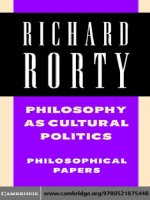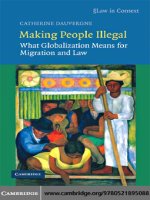cambridge university press after identity rethinking race sex and gender jan 2008 kho tài liệu bách khoa
Bạn đang xem bản rút gọn của tài liệu. Xem và tải ngay bản đầy đủ của tài liệu tại đây (1.11 MB, 267 trang )
This page intentionally left blank
After Identity
Social and political theorists have traced in detail how individuals come to
possess gender, sex, and racial identities. This book examines the nature of these
identities. Georgia Warnke aruges that identities, in general, are interpretations
and, as such, have more in common with textual understanding than we commonly
acknowledge. A racial, sexed, or gendered understanding of who we and others are
is neither exhaustive of the ‘‘meanings’’ we can be said to have, nor uniquely
correct. We are neither always, nor only, black or white, men or women, or males or
females. Rather, all identities have a restricted scope and can lead to injustices
and contradictions when they are employed beyond that scope. In concluding her
argument, Warnke considers the legal and policy implications that follow for
affirmative action, childbearing leave, the position of gays in the military, and
marriage between same-sex partners.
GEORGIA WARNKE
is Professor of Philosophy and Associate Dean for Arts and
Humanities at the University of California, Riverside.
CONTEMPORARY POLITICAL THEORY
SERIES EDITOR
Ian Shapiro
EDITORIAL BOARD
Russell Hardin
Stephen Holmes
Jeffrey Isaac
John Keane
Elizabeth Kiss
Susan Okin
Phillipe Van Parijs
Philip Pettit
As the twenty-first century begins, major new political challenges have arisen at the
same time as some of the most enduring dilemmas of political association remain
unresolved. The collapse of communism and the end of the Cold War reflect a
victory for democratic and liberal values, yet in many of the Western countries
that nurtured those values there are severe problems of urban decay, class and racial
conflict, and failing political legitimacy. Enduring global injustice and inequality
seem compounded by environmental problems, disease, the oppression of women,
racial, ethnic and religious minorities, and the relentless growth of the world’s
population. In such circumstances, the need for creative thinking about the
fundamentals of human political association is manifest. This new series
in contemporary political theory is needed to foster such systematic normative
reflection.
The series proceeds in the belief that the time is ripe for a reassertion of the
importance of problem-driven political theory. It is concerned, that is, with works
that are motivated by the impulse to understand, think critically about, and address
the problems in the world, rather than issues that are thrown up primarily in
academic debate. Books in the series may be interdisciplinary in character,
ranging over issues conventionally dealt with in philosophy, law, history, and the
human sciences. The range of materials and the methods of proceeding should be
dictated by the problem at hand, not the conventional debates or disciplinary
divisions of academia.
Other books in the series
Ian Shapiro and Casiano Hacker-Cordo´n (eds.)
Democracy’s Value
Ian Shapiro and Casiano Hacker-Cordo´n (eds.)
Democracy’s Edges
Brooke A. Ackerly
Political Theory and Feminist Social Criticism
Clarissa Rile Hayward
De-Facing Power
John Kane
The Politics of Moral Capital
Ayelet Shachar
Multicultural Jurisdictions
John Keane
Global Civil Society?
Rogers M. Smith
Stories of Peoplehood
Gerry Mackie
Democracy Defended
John Keane
Violence and Democracy
Kok-Chor Tan
Justice without Borders
Peter J. Steinberger
The Idea of the State
Michael Taylor
Rationality and the Ideology of Disconnection
Sarah Song
Justice, Gender, and the Politics of Multiculturalism
After Identity
Rethinking Race, Sex, and Gender
GEORGIA WARNKE
CAMBRIDGE UNIVERSITY PRESS
Cambridge, New York, Melbourne, Madrid, Cape Town, Singapore, São Paulo
Cambridge University Press
The Edinburgh Building, Cambridge CB2 8RU, UK
Published in the United States of America by Cambridge University Press, New York
www.cambridge.org
Information on this title: www.cambridge.org/9780521882811
© Georgia Warnke 2007
This publication is in copyright. Subject to statutory exception and to the provision of
relevant collective licensing agreements, no reproduction of any part may take place
without the written permission of Cambridge University Press.
First published in print format 2008
ISBN-13 978-0-511-39311-2
eBook (EBL)
ISBN-13 978-0-521-88281-1
hardback
Cambridge University Press has no responsibility for the persistence or accuracy of urls
for external or third-party internet websites referred to in this publication, and does not
guarantee that any content on such websites is, or will remain, accurate or appropriate.
To the memory of my parents
Paul C. Warnke, 1920–2001, and
Jean R. Warnke, 1923–2003
Contents
Acknowledgments
Table of cases
Introduction: reading individuals
page x
xii
1
1 The tragedy of David Reimer
15
2 Racial identification and identity
49
3 Race and interpretation
82
4 Sex and science
120
5 Rethinking sex and gender identities
153
6 Marriage, the military, and identity
188
7 Hermeneutics and the politics of identity
223
Conclusion
245
Index
249
Acknowledgments
My parents were Washington, DC liberals and condemned racism
and sexism in all its forms. As we grew up, they expected us to do
our part. Like other liberal parents in Washington, they forbade us
certain brands of juice and candy, which were associated with the
John Birch Society. They also kept us out of certain stores, movie
theaters, and the local amusement park, which even in the early
1960s remained segregated. When a nursery school teacher told me I
could not be both a mother and a lawyer, my mother said that was the
stupidest thing she’d ever heard. When my sister and I failed to show
keen enough interest in preparing for our careers immediately after
college, my mother sent away for our graduate school applications
herself.
Nevertheless, neither of my parents would have been particularly interested in the issues of racial, sex, and gender identity I raise
in this book. Nor would they necessarily have thought that trying to
understand what these identities are is an important part of overcoming racism and sexism. I dedicate this book to them anyway.
I was proud of them, and for the most part they were pleased
with me.
I would like to thank the National Humanities Center for the
John Medlin Jr. Fellowship it awarded me for the 2004–5 academic
year. I would also like to thank the staff of the Center and the
members of my ‘‘class’’ of fellows, especially Wendy Allanbrook,
Tom Cogswell, Betsy Dain, Deb Harkness, Greg Mitman, Kent
Mulliken, Kevin Ohi, Cara Robertson, and Pete Sigal. I very much
appreciate the support of Ian Shapiro as well as the members of the
Department of Philosophy at the University of California, Riverside
and of the past and present graduate students in the Motley Crew
A C K N O W L E D G M E N T S xi
Workshop. I am grateful to Beth Silverstein for the index, to my
oldest friend, Rosamond Pittman Casey, for the cover, and to John
Haslam, Carrie Cheek, Joanna Breeze, and Barbara Docherty for all
their work on the book.
My sons and the other members of my family know what they
mean to me.
Table of cases
Baker v. Nelson 291 Minn. 310 (1971)
Bennett v. Bennett 10 SE 2d 23 (SC 1940)
Braschi v. Stahl Associates Co. 74 NY 2d 201 (1989)
California Federal Savings and Loan Association v. Guerra 758 F2d 390
(CA 1985)
Equal Employment Opportunity Commission v. Sears, Roebuck &
Co. 504 F. Supp. 241 IL (1980)
Gary v. Stevenson 19 Ark. 580 (1858)
Geduldig v. Aiello 417 US 484 (1974)
General Electric Co. v. Gilbert 429 US 125 (1976)
Goodridge v. Department of Public Health 440 Mass. 309 (2003)
Gray v. The Commonwealth 80 Va. 538 (1885)
Gregory v. Baugh Supreme Court of Virginia 29 Va. 665; 1831
Hernandez v. Robles 7 NY 3d 338 (2006); Supreme Court of New York,
New York County, 794 NYS 2d 579 (2005)
Hook v. Nanny Pagee and Her Children 16 Va. 379 (1811)
Hudgins v. Wrights 11 Va. 134 (1806)
In re Estate of Erlander 145 Misc. 1 (NY 1932)
In re Estate of Marshall G. Gardiner 273 Kan. 191 (2002)
Jones v. The Commonwealth 80 Va. 538 (1885)
Littleton v. Prange 9 SW 223 (Tex. 1999)
Loving v. Virginia 388 US 1 (1976)
McPherson v. The Commonwealth 69 Va. 939 (1877)
M. T. v. J. T. 140 NJ Super 77 (1976)
Perez v. Sharp 32 Cal. 2d 711 (1948)
Richards v. United States Tennis Association 93 Misc. 2d 713 (1977)
Santa Clara Pueblo v. Martinez 436 US 49 (1978)
State v. Asa Jacobs 51 NC 284 (1859)
T A B L E O F C A S E S xiii
State v. Gibson 36 Ind. 389 (1871)
State v. William Chavers 50 NC 11 (1857)
Takao Osawa v. United States 260 US 178 (1922)
The West Chester and Philadelphia Railroad Co. v. Miles 55 PPa. 209
(1867)
Turner v. Safely 482 US 78 (1987)
United States v. Bhagat Singh Thind 261 US 204 (1923)
10 USCS x654 (2005)
Watkins v. United States Army 847 F2d. 1329 (1988)
Wisconsin v. Yoder 406 US 205 (1972)
Zablocki v. Redhail 434 US 374 (1978)
Introduction: reading
individuals
David Reimer’s doctors thought that without a penis he could not be a
boy. His parents and psychologists worried that he was not really a
girl. At the age of three, James Morris decided that he was not a boy.
The Texas Supreme Court concluded that Christie Littleton was not
really a woman and the Kansas Supreme Court had the same view
about J’Noel Ball. The International Olympic Committee decided
Maria Patin˜o was a man while the United States Tennis Association
´ Richards was a woman. What are these
(USTA) decided that Renee
decisions? How do we determine whether we and others are or are not
men and women? What does it mean to be either?
The sense of these questions as I ask them here is different from
the sense they have within discussions in moral psychology. Moral
psychologists focus on the question of which descriptions of others or
ourselves constitute depictions of our identities. The issue here is
which sorts of properties that a person possesses count as parts of his
or her identity and which sorts contribute only to trivial descriptions
of the person. Thus, if it counts as part of one’s identity that one is a
man or a woman – if, in other words, this fact is not simply a trivial
description – the question moral psychology asks is: Why? What constitutes possessing any particular identity? David Copp answers these
questions in a way that highlights their difference from the questions I
want to ask. He proposes that a person’s identity consists in the set of
propositions that a person believes of him or herself and that grounds
his or her negative or positive emotions of self-esteem. Hence, if a
person believes that he is homosexual and this fact grounds positive or
negative emotions of self-esteem, then being homosexual is part of the
person’s identity. Copp thinks that given the issues surrounding
homosexuality in our culture, it would be difficult for a person not
2 AFTER IDENTITY
to identify as a homosexual in either a positive or negative way. He
adds that ‘‘For similar reasons, it is likely that most African Americans
identify as such, that most women identify as such, that most Jews
who know that they are Jewish identify as such.’’1 Copp includes
caveats. First, if a set of propositions is to compose an identity, the
emotions it grounds must be relatively stable. One might weep at a
missed opportunity and the fact that one wept might cause one to feel
ashamed. Yet, unless this shame endures, it does not positively or
negatively affect one’s self-esteem and hence does not ground an
identity as a weeper. Second, identities are affected by particular
cultures and histories so that ‘‘were it not for racism and the history
of slavery, for example, it is unlikely that such a high proportion of
African Americans would have the fact that they are black as part of
their identity.’’2
In the course of this book, I shall question the first caveat and
supplement the second. Nevertheless, I want here simply to use
Copp’s analysis to clarify the initial question I shall ask. Copp’s
analysis is not interested in the question of what it is to be or to be
identified as a homosexual, an African American or a woman. Rather,
the question he asks is what role these identities play in our moral
psychology. The question I want to ask, however, is just what these
identities and identifications are. This question is more interpretive
than psychological. Whereas Copp is interested in developing a theory
that will determine the sets of propositions that can be identities for
us, I am interested in what seems to me to be a prior question: namely,
if ‘‘a high proportion of African Americans . . . have the fact that they
are black as part of their identity,’’ what constitutes ‘‘the fact that
they are black’’? Similarly, if a high proportion of women have the fact
that they are female as part of their identity, what constitutes the
fact that they are female?
1
2
David Copp, ‘‘Social Unity and the Identity of Persons,’’ Journal of Political
Philosophy, 10 (4), 2002, p. 372.
Copp, ‘‘Social Unity and the Identity of Persons,’’ p. 369.
INTRODUCTION 3
To the extent that being a black or African American in the
United States is often more and other than being either the color
black or from Africa, it might seem clear how being black and
African American can be confusing identities to possess and identifications to make. Less clear, perhaps, is how being female or identifying someone else as female can be problematic. Instead, questions here
about being female or identifying others as female may seem to bring
my inquiry close to another discussion. This discussion involves the
terms ‘‘sex’’ and ‘‘gender.’’ While ‘‘sex’’ and ‘‘female’’ have come to be
used to designate fundamental biological facts, the terms ‘‘gender’’ and
‘‘women’’ have come to be used to designate the culturally variable
ways in which that biology can be expressed. This distinction goes
back to Simone de Beauvoir’s, The Second Sex. Although Beauvoir
does not herself use the terms ‘‘sex’’ and ‘‘gender,’’ her book’s most
famous line, ‘‘One is not born, but rather becomes a woman’’3 suggests
a distinction between a female sex with which one is born and a
feminine gender which one acquires. The importance of the difference
between what one is born with and what one acquires lies in its
separation of what are supposed to be invariable biological circumstances from what are meant to be the entirely variable forms those
aspects can take in different cultures and societies.4
Nevertheless, the distinction is not without its dissenters. On
one side are those that dispute the claim that biology is causally
irrelevant to social and cultural roles.5 Men and women are naturally
inclined to different functions for evolutionary reasons insofar as
natural and sexual selection have led to differences in intelligences,
attitudes, and behaviors. Hence sex causes gender. On another side
are those that insist that the causal connection moves in the other
3
4
5
Simone de Beauvoir, The Second Sex (1949), H. M. Parshley trans. and ed. (New York:’’
Knopf, Everyman’s Library, 1993), p. 281.
See Gayle Rubin’s 1975 account, ‘‘The Traffic in Women: Notes on the ‘‘Political
Economy of Sex,’’ in The Second Wave: A Reader in Feminist Theory, Linda
Nicholson, ed. (New York: Routledge, 1997), pp. 27–62.
See Robert Wright, The Moral Animal: Evolutionary Psychology and Everyday Life
(New York: Vintage Books, 1995).
4 AFTER IDENTITY
direction: conceptions of biological sex are themselves culturally conditioned by conceptions of gender and gender classifications already
construct the framework for sex-based classifications.6 Thus,
Monique Wittig claims that gender classifications are part of labor
and political economy7; Judith Butler attributes them to a ‘‘compulsory heterosexual’’ cultural discourse8; and, following Lacan, Juliet
Mitchell traces them to the psychoanalytic ‘‘law of the father.’’9 And
on yet a third side are those who claim that nature and culture are too
entwined to pull apart in any clear or unidirectional way.
Despite their differences, it is noteworthy, at least for my purposes, that the theorists and scientists on the various sides of the
sex–biology or nature–culture debate agree in focusing mainly on
causal issues. They ask how the biology of bodies is causally related
to traits exhibited by men and women or they ask how gender socialization succeeds in dividing bodies into male and female, or, finally,
they ask how biology and society work together to construct males
and females, men and women. Yet, in addition to the question of
how males, females, men and women come to be, we might also ask
what they are. What are we getting at or trying to get at when we
attribute either a sex or a gender to another person or to ourselves?
Copp’s interest is in showing how and when conceiving of oneself as a
female or a woman becomes an identity one possesses; others are
interested in discovering whether one is first a female and then a
woman or first a woman and then a female. For my part, I am interested in what females and women are and how we decide whether a
given individual is one.
6
7
8
9
See, for example, John Macionis, Sociology (Englewood Cliffs, NJ: Prentice Hall,
1993).
Monique Wittig, ‘‘One Is Not Born a Woman,’’ in Nicholson, ed., The Second Wave,
pp. 265–272.
Judith Butler, Gender Trouble: Feminism and the Subversion of Identity (New York:
Routledge, 1990).
Juliet Mitchell, ‘‘Introduction – I,’’ in Juliet Mitchell and Jacqueline Rose, eds.,
´
Feminine Sexuality: Jacques Lacan and the ecole
freudienne (New York:
W. W. Norton and Pantheon Books, 1985).
INTRODUCTION 5
In chapter 1 of this book I ask whether any one knows. For, more
frequently than we might suspect, medical experts, legal authorities,
and psychosexual researchers disagree both with each other and with
themselves. Sometimes authorities rely on chromosomal make-up.
One is a woman if one has XX chromosomes and one is not a woman
if one has XY chromosomes. Yet, what of individuals who have
sex-reassignment surgery or individuals born with an insensitivity to
androgens so that, although they have XY chromosomes, they look
like women? Identity as a woman sometimes ignores chromosomes
and refers to the appearance of the genitalia. At other times it refers to
the set of activities and behaviors that the individual enjoys, or to the
person’s own ideas of who or what he or she is.
Such differences in accounts of who is a woman and in determinations of what counts as female recall similar differences in legal
determinations of who was a black in the nineteenth and twentieth
centuries. State and federal courts investigated the boundaries of US
racial divisions in a variety of contexts. Slave laws prohibited the
enslavement of whites and from the late 1600s on also prohibited
the enslavement of American Indians. After the Civil War, bans on
interracial marriage prevented whites from marrying non-whites.
Until 1952, naturalization laws precluded citizenship for all those
who were neither black nor white. Until at least the mid-1960s Jim
Crow laws limited the access of blacks to almost all public services and
institutions. But how were courts to decide who was what? Just as the
medical, legal, and psychosexual communities disagree on the criteria
for being a woman today, different courts came to different conclusions
about race. Indeed, sometimes the same court came to different conclusions at different times and many courts contradicted themselves
whenever it was necessary to maintain the racial status quo.
Do these cases have any implications for the determination of sex
and gender? Quandaries in racial identification and identity have led to
the now widely accepted account of race as a social construction;
certainly many conceive of sex and gender as social constructions as
well. Part of the point of the present book, however, is to ask whether a
6 AFTER IDENTITY
different conception of racial, sex, and gender identities might not be
equally important. For surely the way we identify ourselves and others
is a way of understanding who or what we and they are. That is, it may
be that the identities we take seriously today are ones with social and
historical causes that constructed people as certain kinds of people. Yet,
identities are also simply interpretations of who people are, interpretations that select among the various possibilities in our culture and
tradition for saying who and what people are. As ways of understanding,
however, identities possess the same features as understanding in general and the same features, in particular, as understanding texts. When
we ask who someone is, we are asking the same sort of question we ask
when we want to know what the meaning of a particular text is; we are
trying to understand the person’s ‘‘meaning.’’
Textual understanding has at least three characteristics that are
important for thinking through the questions of identities. First, our
understanding of texts is situated. We do not come at our texts with a
fresh eye but instead with one that is pre-oriented towards the text in a
certain way because of the culture and traditions in which we have
been socialized. Second, our understanding of texts is purposeful.
When we understand a text, we do so not only from a certain perspective and not only within a certain framework of assumptions and
concerns. In addition, we have certain hopes and expectations for the
text, certain reasons for reading it, and particular worries we would like
it to address. Third, because we recognize ourselves as situated and
purposefully oriented, we are prepared for different interpretations of
the text’s meaning. We assume that others have and will understand it
differently than we do and, moreover, that we may bring a different
framework of attitudes, expectations, and concerns to it at different
points of our life. In this book, I want to suggest that our understanding
of a person’s identity is likewise situated, purposefully oriented, and
partial. As Copp’s work suggests, it is not novel to assert that understanding another person or oneself as a black is possible only because of
the particular history out of which we have emerged. The same holds of
races in general: we can understand people as raced individuals only
INTRODUCTION 7
because of and within limited historical and cultural contexts. Indeed,
a particular person can be a black in the United States and a white in
Latin America and the possibility of his or her being either black or notblack depends upon the particular histories of the particular racial
traditions involved. Nevertheless, I also want to make a further
claim: even within the historical and cultural settings in which we
can be understood as black, white, Asian or Latino/a and in which we
can be understood as females or males, men or women, we cannot only
or always be understood in any of these ways. Particular historical and
cultural contexts may give rise to racial, sexed, and gendered identities.
It is a further point to say that only particular contexts within those
broader historical and cultural frameworks can include raced, sexed, or
gendered individuals as intelligible ‘‘parts.’’
The contradictions in identity attribution that I explore in chapter 1 and 2 of this book are the result of ignoring these sorts of limits on
intelligibility. Just like texts, people have different meanings in different contexts and the meanings they have depend upon the relations,
situations, and frameworks in terms of which we are trying to understand them. When we understand who a person or ourselves is, we do
so only from a certain perspective and only within a certain framework of assumptions and concerns. Hence, our understanding of ourselves and others is always partial and perspectival. An identity is
never either the whole of who we are or who we always are. Rather,
who we are depends upon the context in which the question arises and
the purposes for which it is asked. The source of contradictions in
legal, social, and medical accounts of which race, sex, or gender a given
person has stems from a failure to recognize that identities are always
situationally curtailed. In chapters 6 and 7 of this book I try to make
this point clear by looking at debates over the politics of recognition,
marriage between same-sex partners, and gays in the military. For, in
each of these cases, particular identities overflow the arenas only
within which they make sense.
Much of what I say in this book touches on two other important
issues. The first involves our assumptions about the binary nature of
8 AFTER IDENTITY
sexes and genders and the second asks what is excluded in our use of
the category of ‘‘women.’’ In the hope of further clarifying my own
focus, I want to look briefly at both discussions.
The issue of the binary nature of sex and gender raises the
question as to whether we must or even should sort people into one
or the other of two and only two sets: male or female, man or woman.
Are there two and only two sexes coordinated with two and only two
genders? Adding intersexed individuals to our current binary system,
Anne Fausto-Sterling once somewhat facetiously proposed what she
called a five-sex system consisting of men, women, herms (intersexuals with equal portions of male and female attributes), ferms
(intersexuals with a high proportion of female attributes), and
merms (intersexuals with a higher proportion of male attributes).10
In contrast, according to Thomas Laqueur, Europe used a one-sex
model until the latter part of the eighteenth century.11 Metaphysical
commitments about the hierarchy of nature required that men and
women belong to the same order so that men could be placed above
women in the scheme of things. The scheme did not require physicians to overlook all differences between men and women. These they
saw in terms of oppositions between cold and heat, moist and dry.
Nevertheless, they tended to think that the oppositions occurred
within a single sex: female bodies were outside-in male bodies, as
Aristotle and Galen said, possessing the same telos as men but without sufficient heat to take the male form to its perfect completion.12 It
followed from this view that women with too much bodily heat could
produce semen and that if women became entirely too hot through
exercise they might suddenly sprout penises.13
10
11
12
13
See Anne Fausto-Sterling, Sexing the Body: Gender Politics and the Construction of
Sexuality (New York: Basic Books, 2000), p. 78.
Thomas M. Laqueur, Making Sex: The Body and Gender from the Greeks to Freud
(Cambridge, MA: Harvard University Press, 1990).
Ibid., p. 4.
Ibid., pp. 123–126. Also see Merry E. Wiesner, Women and Gender in Early Modern
Europe, 2nd edn. (Cambridge: Cambridge University Press, 2000), p. 54.
INTRODUCTION 9
Despite the apparent eccentricity of such beliefs, Laqueur does
not think that they can be explained simply as the result of inadequate
medical and scientific knowledge. The discovery of the clitoris during
the Renaissance could have been used to undermine these beliefs
because it meant that the model had to deal with two penis analogues:
the vagina and the clitoris.14 Conversely, the discovery of ‘‘a morphologically androgynous embryo’’15 in the nineteenth century could
have been used to support a one-sex model. Laqueur therefore cites
extra-scientific causes for the move to a two-sex model. The premodern and early-modern body occupied a different conceptual space
from the modern one. It was not the bedrock material substance on
which various attributes could be hung. Instead, it was an illustration of
the cosmic order in which microcosm and macrocosm were mapped
onto one another and in which men and women had their proper places
as two genders hierarchically positioned along a single body.
Numerous historical and anthropological investigations indicate that we need not be content with only two genders, however.
Randolph Trumbach argues that ‘‘mollies,’’ or adult, transvestite,
effeminate homosexuals constituted a third gender in England and
Northwestern Europe in the eighteenth century and that ‘‘sapphists’’
or lesbians constituted a fourth gender in the nineteenth century.16
In regions of the Balkans, at least up to the early twentieth century,
daughters were sometimes raised as sons and women sometimes
lived as men, receiving certain male privileges and answering to
male pronouns.17 Perhaps the most famous of the additional genders,
however, are the berdaches or Two-Spirits of certain American Indian
14
16
17
15
Laqueur, Making Sex, p. 65.
Ibid., p. 10.
Randolph Trumbach, ‘‘London’s Sapphists: From Three Sexes to Four Genders in the
Making of Modern Culture,’’ in Gilbert Herdt, ed., Third Sex, Third Gender: Beyond
Sexual Dimorphism in Culture and History (New York: Zone Books, 1993),
pp. 111–136.
See, for example, ‘‘Woman Becomes Man in the Balkans,’’ in Herdt, ed., Third Sex,
Third Gender, pp. 241–281.









